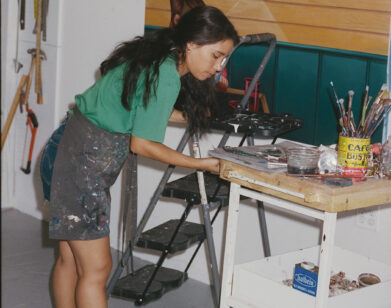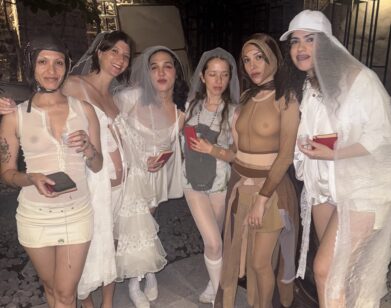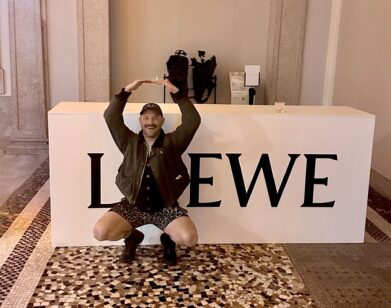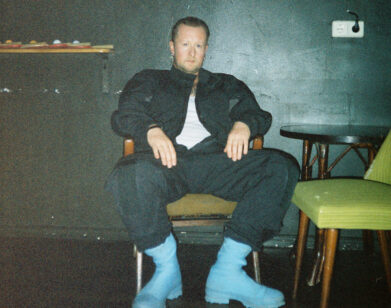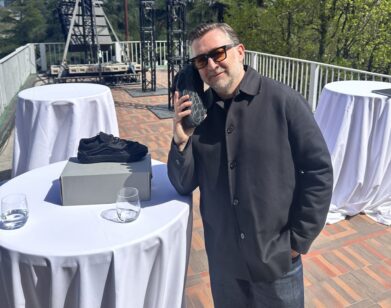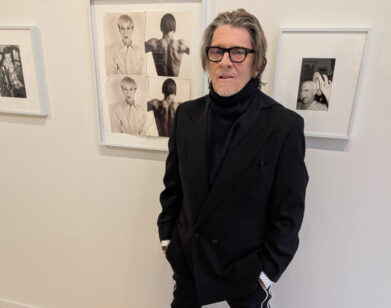From the Subways to Soho
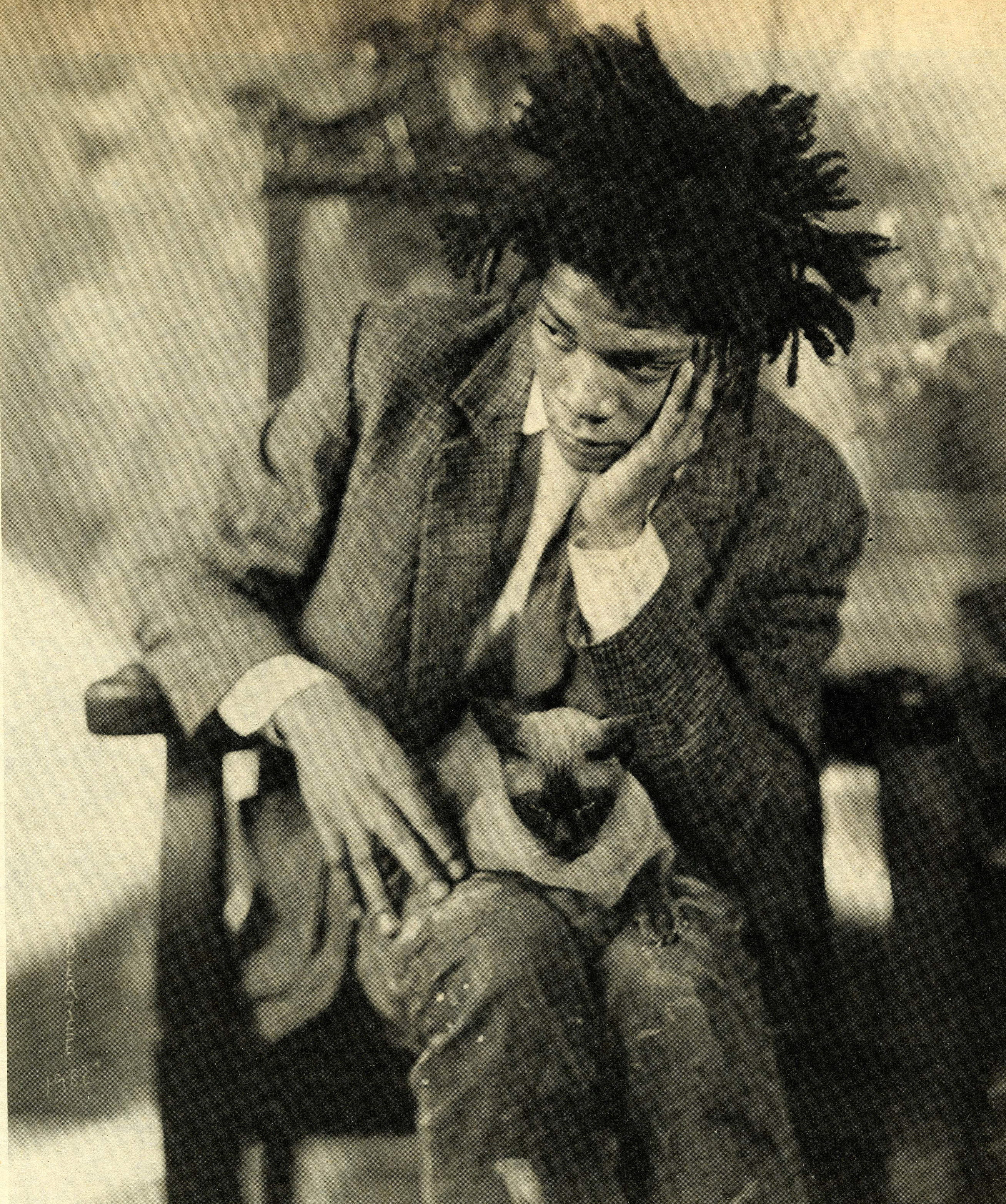
Lil Wayne, he of the body suit of tattoos and endless puns, clearly has a keen visual eye, an unrivaled vocabulary, and an intimate understanding of how his audience on the street perceives itself. So it makes sense that we asked him about his favorite visual art, Wayne chose the equally irreverent, graffiti-inspired works of the late visual artist, Jean-Michel Basquiat. Incidentally, both share childhoods filled with precocious displays of artistic talent, and affinities for rule-breaking and boundary-bending. Basquiat, for his part, threw a cake at his principal on the day of his graduation from high school.
Lucky for us, we have on our hands an early discussion (from the January 1983 issue) between Basquiat and famed Metropolitan curator Henry Geldzahler. Wayne never leads us in the wrong direction.
PHOTO BY JAMES VAN DER ZEE
In 1976, Jean-Michel Basquiat began “writing” his unique brand of graffiti throughout Manhattan under the name “SAMO.” His work from the first consisted of conceptual, enigmatic combinations of words and symbols, executed with the curt simplicity of a late Roman inscription. Graduating from subway walls to canvas and from the streets of New York to the galleries of Soho, Basquiat took the art world by storm with his rampageous one man show at Annina Nosei’s gallery, early in 1982. His first one-man show, perhaps ironically, was not in New York, but in Italy, in Modena. Exhibitions since then have included Documenta 7 and the Fun Gallery, New York.
HENRY GELDZAHLER: Did you ever think of yourself as a graffiti artist, before the name became a middle class luxury?
JEAN-MICHEL BASQUIAT: I guess I did.
HG: Did you work in the streets and subways because you didn’t have materials or because you wanted to communicate?
JMB: I wanted to build up a name for myself.
HG: Territory? Did you have an area that was yours?
JMB: Mostly downtown. Then the “D” train.
HG: How’d you pick up the “D” train?
JMB: That was the one I went home on, from downtown to Brooklyn.
HG: But you knew Brooklyn wasn’t going to be your canvas from the beginning. Manhattan was where the art goes on, so that was where you were going to work?
JMB: Well, SAMO wasn’t supposed to be art, really.
HG: What were the materials?
JMB: Black magic marker.
HG: On anything? Or something that was already prepared and formed?
JMB: The graffiti? No, that was right on the streets.
HG: Did you have any idea about breaking into the art world?
JMB: No.
HG: But when I saw you, you were about 17 years old. You were showing me drawings, that was 4 or 5 years ago… I was in the restaurant, WPA, in Soho.
JMB: Yeah, I remember.
HG: So you already had work to show.
JMB: No, I was selling these postcards and somebody told me you had just gone into this restaurant. It took me about 15 minutes to get up the nerve to go in there. I went in and you said, “Too young.” And I left.
HG: Cruel, but true.
JMB: It was true at the time.
HG: Were you furious?
JMB: Sort of. I mean, too young for what, you know? But I could see, it was lunch time. “Who is this kid?”
HG: The next time I saw you was about two years later above a loan shop at the entrance to the Manhattan Bridge. I was very impressed; I was amazed, especially by the picture I got. Is that going to fall apart? Should I have it restuck, or put it behind glass?
JMB: Anything is fine. A little gold frame.
HG: What was your idea of art as a kid? Did you go to the Brooklyn Museum?
JMB: Yea, my mother took me around a lot.
HG: Did you have any idea what Haitian art was?
JMB: No I wanted to be a cartoonist when I was young.
HG: When I first met you, you mentioned Franz Kline.
JMB: Yeah, he’s one of my favorites.
HG: I heard you’ve been spreading a rumor that you wanted to have a boxing match with Julian Schnabel.
JMB: This was before I’d ever met him. And one day he came into Annina’s gallery. And I asked him if he wanted to spar.
HG: He’s pretty strong.
JMB: Oh yeah, I thought so. But I figured even if I lost, I couldn’t look bad.
HG: Whose paintings do you like?
JMB: The more I paint the more I like everything.
HG: Do you feel a hectic need to get a lot of work done?
JMB: No. I just don’t know what else to do with myself.
HG: Painting is your activity, and that’s what you do…
JMB: Pretty much. A little socializing.
HG: Do you still draw a lot?
JMB: Yesterday was the first time I’d drawn in a long time. I’d been sort of living off this pile of drawings from last year, sticking them on paintings.
HG: Are you drawing on good paper now or do you not care about that?
JMB: For a while I was drawing on good paper, but now I’ve gone back to the bad stuff. I put matte medium on it. If you put matte medium on it, it seals it up, so it doesn’t really matter.
HG: I’ve noticed in the recent work you’ve gone back to the idea of not caring how well stretched it is; part of the work seems to be casual…
JMB: Everything is well stretched even thought it looks like it may not be.
HG: All artists, or all art movements, when they want to simplify and get down to basics, eliminate color for a while, then go back to color. Color is the rococo stage, and black and white is the constructed, bare bones. You swing back and forth so very quickly in your work. Are you aware of that?
JMB: I don’t know.
HG: If the color gets too beautiful, you retreat from it to something angrier, more basic…
JMB: I like the ones where I don’t paint as much as others, where it’s just a direct idea.
HG: Like the one I have upstairs.
JMB: Yeah. I don’t think there’s anything under that gold paint. Most of the paintings have one or two paintings under them. I’m worried that in the future, parts might fall off and some of the heads underneath might show through.
HG: They might not fall off, but paint changes in time. Many Renaissance paintings have what’s called “pentimenti,” changes where the “ghost” head underneath which was five degrees off will appear.
JMB: I have a painting where somebody’s holding a chicken, and underneath the chicken is somebody’s head.
HG: It won’t fall off exactly like that. The whole chicken won’t fall off.
JMB: [laughs] Oh.
HG: Do you do self-portraits?
JMB: Every once in a while, yeah.
HG: Do you think your family is proud of you?
JMB: Yeah, I guess so.
HG: What did you think of James Van Der Zee?
JMB: Oh, he was really great. He has a great sense of the “good” picture.
HG: What kind of camera did he use?
JMB: Old box camera that had a little black lens cap on the front that he’d take off to make the exposure, then put back on.
HG: Do you find your personal life, your relationships with various women get into the work?
JMB: Occasionally, when I get mad at a woman, I’ll do some great, awful painting about her…
HG: Which she knows is about her, or is it a private language?
JMB: Sometimes. Sometimes not.
HG: Do you point it out?
JMB: No, sometimes I don’t even know it.
HG: Do friends point it out to you, or does it just become obvious as time goes on?
JMB: It’s just those little mental icons of the time…
HG: Clues.
JMB: There was a woman I went out with…I didn’t like her after a while of course, so I started painting her as Olympia. At the very end I cut the maid off.
HG: Who’s harder to get along with, girlfriends or dealers?
JMB: They’re about the same, actually.
HG: Did you have a good time when you went to Italy, for the first show, in Modena?
JMB: It was fun because it was the first time, but financially it was pretty stupid.
HG: It was a rip-off?
JMB: Yeah, he really got a bulk deal.
HG: Has he re-sold them? Are they out in the world?
JMB: I guess so.
HG: Do you ever see them? Would you recognize them?
JMB: I recognize them. I’m a little shocked when I see them.
HG: Are there Italian words in them?
JMB: Mostly skelly-courts and strike zones.
HG: What’s a skelly-court?
JMB: It’s a street game, with a grid.
HG: What about the alchemical works, like tin and lead…
JMB: I think that worked.
HG: I think so, too.
JMB: Because I was writing gold on all this stuff, and I made all this money right afterwards.
HG: What about words like tin and asbestos?
JMB: That’s alchemy, too.
HG: What about the list of pre-Socratic philosophers in the recent paintings, and the kinds of materials which get into your painting always, that derive not so much from Twombly as from the same kind of synthetic thinking. Is that something you’ve done from your childhood, lists of things?
JMB: That was from going to Italy, and copying names out of tour books, and condensed histories.
HG: Is the impulse to know a lot, or is the impulse to copy things that strike you?
JMB: Well, originally I wanted to copy the whole history down, but it was too tedious so I just stuck to the cast of characters.
HG: So they’re kinds of indexes to encyclopedias that don’t exist.
JMB: I just like the names.
HG: What is your subject matter?
JMB: [pauses] Royalty, heroism, and the streets.
HG: But your picture of the streets is improved by the fact that you’ve improved the streets.
JMB: I think I have to give that crown to Keith Haring. I haven’t worked in the streets in so long.
HG: How about the transition from SAMO back to Jean Michel, was that growing up?
JMB: SAMO I did with a high school friend, I just didn’t want to keep the name.
HG: But it became yours…
JMB: It was kind of like… I was sort of the architect of it. And there were technicians who worked with me.
HG: Do you like showing in Europe and the whole enterprise of having a dealer invite you, going over and looking at the show…
JMB: Usually, I just have to go myself and I have to pay my own ticket ’cause I don’t know how to ask diplomatically…
HG: You are a bit abrupt.
JMB: And then I usually want to go with friends so I have to pay for them as well.
HG: So you end up not making very much money out of your show.
JMB: It’s okay.
HG: Do you like the idea of being where the paintings are?
JMB: Usually I have to check up on these dealers and make sure they’re showing the right work. Or just make sure that it’s right.
HG: I like the drawings that are just lists of things.
JMB: I was making one in an airplane once. I was copying some stuff out of a Roman sculpture book. This lady said, “Oh, what are you studying.” I said, “It’s a drawing.”
HG: I think “What are you studying” is a very good question to ask—because your work does reflect an interest in all kinds of intellectual areas that go beyond the streets, and it’s the combination of the two.
JMB: It’s more of a name-dropping thing.
HG: It’s better than that. You could say that about Twombly, and yet somehow he drops the name from within. With your work it isn’t just a casual list. It has some internal cohesion with what you are.
JMB: My favorite Twombly is Apollo and The Artist, with the big “Apollo” written across it.
HG: When I first met you, you were part of the club scene… the Mudd Club.
JMB: Yeah, I went there every night for two years. At that time I had no apartment, so I just used to go there to see what my prospects were.
HG: You used it like a bulletin board.
JMB: More like an answering service.
HG: You got rid of your telephone a while ago. Was that satisfying?
JMB: Pretty much. Now I get all these telegrams. It’s fun. You never know what it could be. “You’re drafted.” “I have $2,000 for you.” It could be anything. And because people are spending more money with telegrams they get right to the point. But now my bell rings at all hours of the night. I pretend I’m not home…
HG: Do you want a house?
JMB: I haven’t decided what part of the world isn’t going to get blown-up so I don’t know where to put it.
HG: So you do want to live…
JMB: Oh yeah, of course I want to live.
HG: Do you want to live in the country or the city?
JMB: The country makes me more paranoid, you know? I think the crazy people out there are a little crazier.
HG: They are, but they also leave you alone more.
JMB: I thought they’d be looking for you more, in the country. Like hunting, or something.
HG: Have you ever slept in the country, over night?
JMB: When I said I was never gonna go home again I headed to Harriman State Park with two valises full of canned food…
HG: In the summer?
JMB: It was in the fall.
HG: And you slept overnight?
JMB: Yeah, two or three days.
HG: Were you scared?
JMB: Not much. But yeah, in a way. You know, you see some guys with a big cooler full of beer. And it gets really dark in the woods, you don’t know where you are.
HG: Do you like museums?
JMB: I think the Brooklyn is my favorite, but I never go much.
HG: What did you draw as a kid, the usual stuff?
JMB: I was a really lousy artist as a kid. Too abstract expressionist; or I’d draw a big ram’s head, really messy. I’d never win painting contests. I remember losing to a guy who did a perfect Spider-Man.
HG: But were you satisfied with your own work?
JMB: No, not at all. I really wanted to be the best artist in the class, but my work had a really ugly edge to it.
HG: Was it anger?
JMB: There was a lot of ugly stuff going on at the time in my family.
HG: Is there anger in your work now?
JMB: It’s about 80% anger.
HG: But there’s also humor.
JMB: People laugh when you fall on your ass. What’s humor?

